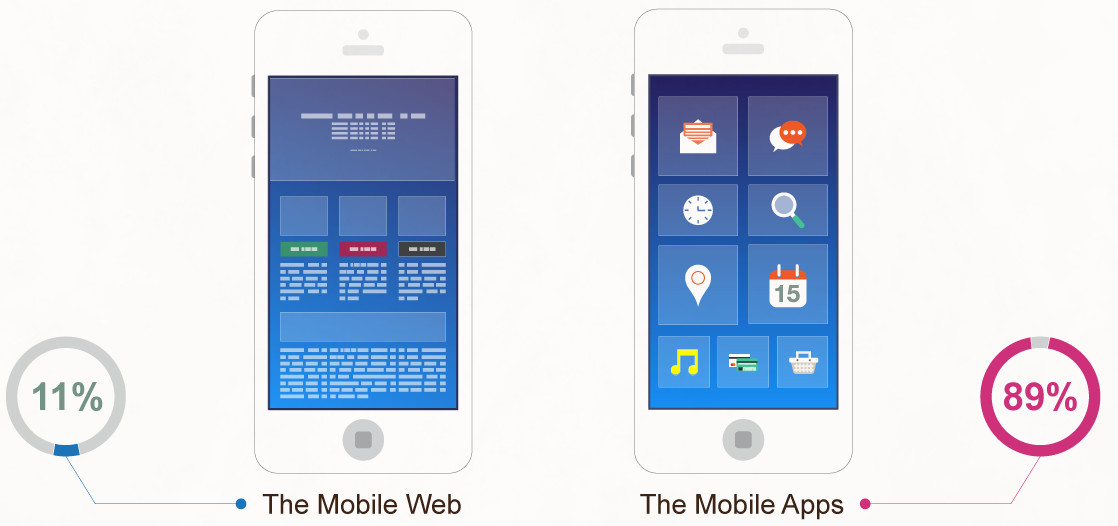As mobile adoption rates continue to soar, IR professionals must adapt their stakeholder outreach strategies accordingly.
Today, nearly every business has an online presence in some shape or form — but over the last few years, apps and mobile websites have emerged as the two primary resources for accessing information on-the-go, or otherwise.
According to comScore, over 75% of mobile subscribers in the U.S. own smartphones. Moreover, the average person spends over 2 hours and 42 minutes on their mobile devices each day, as Best Android Apps points out. As smartphones play an increasingly important role in our day-to-day lives, the mobile optimization of internet-based services is becoming a baseline expectation for both the business community and consumers across the globe.
While nearly everyone is familiar with these technologies to a certain extent, the key distinctions between apps and mobile websites may not be immediately clear — at least not in terms of their respective applications in the world of modern investor relations. Let’s take a closer look at each one of these platforms, and try to better understand the crucial role that each plays in the overall IR spectrum.
What’s the Difference?
At first glance, mobile websites and apps seem to share the same, basic functionality: easy access to highly organized information. Yet each platform has its own unique set of strengths:
A mobile app is a specialized piece of software downloaded to a mobile device with highly specialized, built-in functions and services. Apps are intuitively proactive, both visually and in the way they behave. They boast easy, one-touch accessibility from a mobile device’s home screen, instead of passively hiding behind a cumbersome web browser search. Similarly, apps have powerful notification tools that can reach out and alert the user whenever significant news or information is released.
A mobile website is exactly what it sounds like — it’s a website that has been visually optimized for use on mobile screens. It’s essentially a streamlined version of a full site that one would encounter via PC-based browsing, offering a limited selection of content along with shortcut buttons for some of the most commonly utilized functions of the site. While mobile websites are often stripped down for easier navigation, they still serve as a way for stakeholders to access a wealth of important information.
Key App Advantages
Convenience is one of the mobile app’s key assets — instead of having to open a web browser and enter a URL or do a Google search, the platform boasts simple, one-touch accessibility via an icon on a smartphone’s homescreen. Apps can also can provide access to offline resources for stakeholders who may be traveling and don’t have access to WiFi.
Apps also ensure that important information proactively finds its way into the hands of app users. The proactivity of the notification tools allows companies to establish a more-connected relationship with stakeholders.
According to Business News Daily, apps also give companies “the advantage of having their own corner on a customer’s device”. In other words, because users actually have to download and install the app on their phones, companies have more control over their presence and their ability to communicate effectively.
In terms of user preference, research conducted by Nielsen shows that 89% of a smartphone user’s internet time is now spent inside mobile apps, with only 11% being spent on the mobile web. In other words, adding a mobile app into your existing communications program is more important now than ever before.
Think Big Picture
Today, mobile optimization is a non-negotiable requirement within the business community. People expect instant, seamless access to information and intuitive channels for meaningful, clear communication — without a mobile presence, your company is effectively swimming upstream in its efforts to remain in-step with IR best practices and trends across the globe.
Simply put, an effective IR program in the 21st century demands a holistic approach. Traditional websites, mobile websites, social media, apps, and newsletters all play a crucial role in not only keeping company stakeholders up-to-date, but also in demonstrating that your organization is committed to transparency and ensuring that information is easily accessible via as many platforms as possible. What’s clear is that as mobile usage rates and smartphone penetration continue to grow, the absence of apps and mobile websites from a company’s IR offerings won’t slip by unnoticed.
(Main image credit: The DEMO Conference/flickr)


